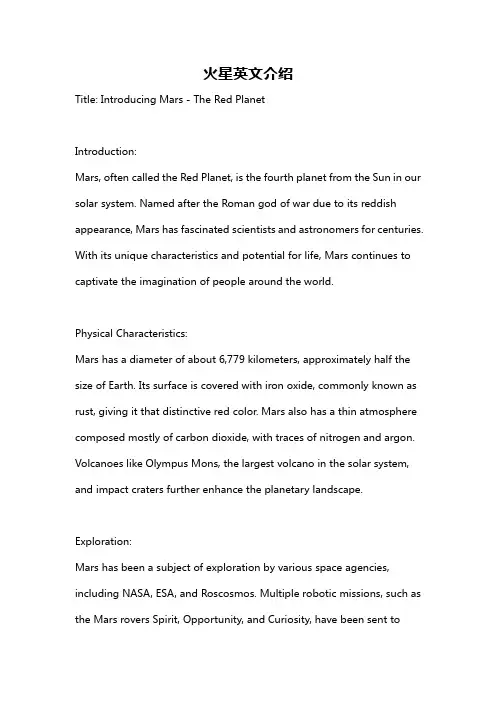火星介绍 英语ppt
- 格式:ppt
- 大小:1.88 MB
- 文档页数:12


Planet Profile星球简介Mars火星The Red Planet has a host of new robots investigating it这颗红色星球有很多新的机器人正在研究它Across the gulf of space, no other planet has fired humanity’s imagination so much as the Red Planet, and it has frequently been associated with violence, war and death. To the ancient Sumerians it was Nergal, a god of war and plague who presided over the netherworld. In Mesopotamia it was the ‘star of judgement of the fate of the d ead’. The Chinese associated it with the element fire, while for the people of the Tiwi Islands off the coast of Australia the planet was one of the four wives of the Moon Man, who followed the path of the Sun Woman through the sky –the other wives were Mercury, Jupiter and Venus. The planet was a familiar sight to the astronomers of ancient Egypt, Babylonia, Rome –where Mars was the god of war –and Greece, where Aristotle noticed that the planet vanished behind the Moon during an occultation, proving it was farther away.穿过太空湾,没有任何一颗星球能像红色星球那样激发人类的想象力,而且它经常与暴力、战争和死亡联系在一起。



火星英文介绍Title: Introducing Mars - The Red PlanetIntroduction:Mars, often called the Red Planet, is the fourth planet from the Sun in our solar system. Named after the Roman god of war due to its reddish appearance, Mars has fascinated scientists and astronomers for centuries. With its unique characteristics and potential for life, Mars continues to captivate the imagination of people around the world.Physical Characteristics:Mars has a diameter of about 6,779 kilometers, approximately half the size of Earth. Its surface is covered with iron oxide, commonly known as rust, giving it that distinctive red color. Mars also has a thin atmosphere composed mostly of carbon dioxide, with traces of nitrogen and argon. Volcanoes like Olympus Mons, the largest volcano in the solar system, and impact craters further enhance the planetary landscape.Exploration:Mars has been a subject of exploration by various space agencies, including NASA, ESA, and Roscosmos. Multiple robotic missions, such as the Mars rovers Spirit, Opportunity, and Curiosity, have been sent toexplore the planet's surface, providing valuable data about its geology and potential for life. Additionally, the recent successful landing of NASA's Perseverance rover in February 2021 opens up new possibilities for uncovering Mars' history and signs of ancient life.Potential for Life:One of the most exciting aspects of Mars is its potential for supporting life. Although the planet's extreme cold, thin atmosphere, and lack of liquid water make it inhospitable for humans, the discovery of water ice at the polar caps and underground raises hopes for microbial life. Future missions aim to search for traces of microbial life and study the habitability of Mars in more detail, with the ultimate goal of sending humans to the planet in the future.Future Exploration:The exploration of Mars is an ongoing endeavor, with multiple planned missions in the coming years. NASA's Artemis program aims to put humans back on the Moon, as a stepping stone towards Mars colonization. Private companies like SpaceX also have ambitious plans to send humans to Mars within the next few decades. These efforts reflect the growing interest in understanding Mars' potential for life and expanding our presence in the universe.Conclusion:Mars, with its unique physical characteristics, ongoing exploration efforts, and potential for life, continues to captivate humanity. As we strive to uncover the mysteries of this captivating planet, Mars represents an exciting destination for future exploration and holds the promise of changing our understanding of our place in the universe.。


火星内部英文介绍Mars, also known as the Red Planet, is the fourth planet from the sun and one of the most studied celestial bodies in our solar system. Along with its surface features and atmosphere, scientists have been interested in learning more about Mars' internal makeup. In this article, we will discuss what we know about the interior of Mars and how it was discovered.Step 1: How do we know about the interior of Mars?Unlike Earth, we cannot directly observe the interior of Mars. However, scientists have used a variety of techniquesto study Mars' interior, including:- Orbital missions: These spacecraft use gravity measurements to map variations in the planet's gravitational field, revealing structures beneath the surface.- Seismic studies: Like on Earth, Mars' surface experiences seismic activity. Seismic waves can reveal information about the interior structure of the planet.- Meteorite studies: Some meteorites that originated from Mars contain minerals that can only form under certain conditions that are thought to occur in Mars' mantle.Step 2: What is the structure of Mars' interior?Through these methods, scientists have determined that Mars' interior consists of three main layers: the crust, mantle, and core. The crust is thought to be about 30-50 km thick, while the mantle and core make up the rest of the planet's interior.The mantle is a thick layer that surrounds the core andis made up of hot, partially molten rock. The core, which is thought to be about 1,800 km in diameter, is believed to be made up of iron and nickel.Step 3: What do we know about Mars' core?While scientists are still learning about the details of Mars' core, they believe that it is partly molten and that it does not have a strong magnetic field like Earth's core. This lack of a magnetic field may be due in part to the fact that Mars' core is cooling and solidifying, which would prevent the formation of a magnetic field.Step 4: What does Mars' interior tell us about its history?By studying the interior of Mars, scientists hope to learn more about the planet's history and how it has evolved over time. For example, the size and composition of Mars' core may provide insights into how the planet formed and how it has changed since then.Additionally, understanding the interior structure of Mars may help us better understand the planet's surface features and why they look the way they do. For example, by studying Mars' mantle, scientists may be able to explain why some areas of the planet have higher elevation and thicker crusts than others.Conclusion:While we still have much to learn about the interior of Mars, studying this aspect of the planet is crucial to understanding its evolution and place in the solar system. As technology continues to improve, we can look forward to exciting new discoveries about the Red Planet's inner workings.。



